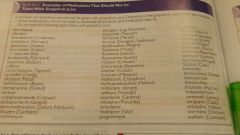![]()
![]()
![]()
Use LEFT and RIGHT arrow keys to navigate between flashcards;
Use UP and DOWN arrow keys to flip the card;
H to show hint;
A reads text to speech;
30 Cards in this Set
- Front
- Back
|
Cross-sensitivity |
Meds that share common actions may also share common adverse effect |
|
|
Anaphylactic |
Severe, total body life threatening adverse reaction. May result from administration of any drug. |
|
|
Classification of med |
Helpful for implementation of appropriate actions before administrating med. This can prevent overdose or adverse reactions |
|
|
FDA pregnancy categories |
Cat A - no risk documented Cat b- animal studies have no risk, on humans it has inadequate risk. Also flipped around. Cat C- animal studies have adverse effects, no adequate studies in human, or no adequate studies in both. Cat D- human fetal risk, benefits may out wight potential risk Cat X- abnormalities documented |
|
|
Key concept |
A person may be allergic to any med at any time, always watch for signs, also ask if any other med are being taken, mixed together can have serious sideffect |
|
|
Food and meds |
Some meds interact negatively with certain foods. Some meds should be taken with food, while others with empty stomach |
|
|
Drug and drug interactions |
Can have possible interaction that lead to decreased effects, or overdose of the drug. |
|
|
Meds not to be taken with grapefruit juice |

|
|
|
Anti infective agent |
Medication used to treat an infection |
|
|
Antibiotic |
Type of anti infective agent, is a chemical compound use to treat bacterial infections |
|
|
Antibiotic classes |
Broad spectrum- effective against many organisms. Narrow spectrum- effective against only a few MO. |
|
|
Bacteriostatic |
Antibiotics that retard the growth of bacteria. |
|
|
Bactericidal |
Kill bacteria |
|
|
Speed of action of med |
Controlled release- slowly released over time Delayed release- begins after period of time. Extended release- release over long period of time Immediate release- immediately Sustained release- release over period of time Depot, decanoate- release for 2-3 weeks Transdermal - release for 12hr to 30 days |
|
|
Key comcept |
Many antibiotics reduce the bacteria strenght, our body then take over to actually kill pathogen |
|
|
Antibiotic effectiveness |
Must be soluble in water, and diffuse readily into body tissue. Should not cause allergic, or affect normal flora, or antagonist to other antibiotics |
|
|
Antibiotic resistant organism |
When antibiotics are used indiscriminately, or administer improperly. Certain pathogen mutate and form a resistance |
|
|
Selecting appropriate antibiotic |
Order a C&S test, to determine the MO, then we determine what antibiotic it's most sensitive to. |
|
|
Key concept |
To ensure accurate results, antibiotic therapy should not start until after C&S is obtained |
|
|
Most common antibiotics |
Penicillin, cephalosporins, tetracycline, aminoglycoside, macrolides, & sulfonamides |
|
|
Penicillin |
Kills bacteria, bactericidal. Available in liquid, tablets, parenteral forms. Safest is oral route. |
|
|
Penicillin side effects |
Only to 5% of North America. Mild effects are nausea, sore mouth, diarrea. More severe are hives, fever, rash, dyspnea |
|
|
Cephalosporins |
Like PCN, devoted from mold. 10% of people allergic to PCN also allergic to cephalosporins. Divided into 3 groups; 1st,2nd,3rd generation and are based on range of medications specificity. Used frequently for mixed infections. |
|
|
Nursing alert |
If patient drinks alcohol while taking cephalosporins, severe nausea and vomiting are likely |
|
|
Tetracycline TCN |
A broad spectrum antibiotics that's effective against wide variety of organisms. Often used for patient allergic to PCN. To promote absorption, should be taken on empty stomach. Side effects can include photosensitivity, nausea, vomiting, diarrhea |
|
|
Aminiglycoside |
Potent bactericidal antibiotic. Active against aerobic gram negative organisms, particularly those causing UTI and life threatening septicemias. Can cause ototoxicity and nephrontoxicity |
|
|
Ototoxicity |
Cause by damage to eight cranial nerve, causing hearing loss, diziness, and tinnitus |
|
|
Nephrontoxicity |
Kidney damage, manifested by blood and protein in the urine |
|
|
Macrolide antibiotic |
Are narrow spectrum bactrriostatic agents. Effective against most MO that are sensitive to PCN and are used to treat respiratory tract infections in clients allergic to PCN. |
|
|
Sulfonamide |
Are bacteriostatic agents Used for antimicrobial agents. They are being replace by better agents. |

